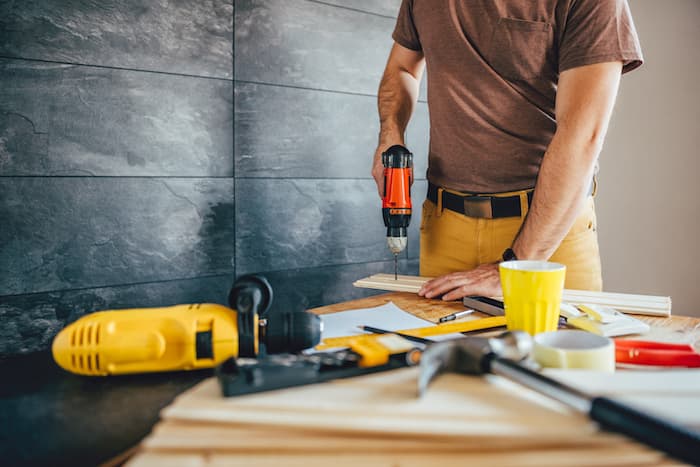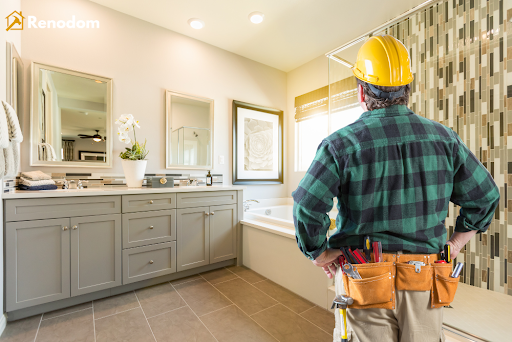Home renovation can be a daunting task, even for the most enthusiastic DIY home renovator. The process involves a lot of planning, research, and execution. However, with the right tools, the process can become much more manageable and less stressful. In this article, we will introduce you to home renovation tools that are perfect for DIY home renovation enthusiasts.
Home renovation projects often require a variety of tools to handle different tasks. Here’s a list of essential tools commonly used in home renovation:

Content
Basic Tools
- Hammer: For driving nails and minor demolition.
- Screwdrivers: Both flat-head and Phillips-head for driving screws.
- Pliers: Useful for gripping, bending, and cutting wires.
- Measuring Tape: For accurate measurements.
- Level: Ensures your work is perfectly horizontal or vertical.
- Utility Knife: For cutting various materials.
- Chisels: Useful for detailed woodwork or removing old material.
Cutting Tools
- Hand Saw: For cutting wood.
- Circular Saw: For cutting larger pieces of wood quickly.
- Jigsaw: For making curved cuts in wood and other materials.
- Reciprocating Saw: Ideal for demolition work.
- Miter Saw: For making precise crosscuts and miters in wood.
Drilling and Driving Tools
- Cordless Drill/Driver: For drilling holes and driving screws.
- Impact Driver: Provides more torque for driving screws and bolts.
- Hammer Drill: For drilling into masonry and concrete.
Painting and Finishing Tools
- Paint Rollers and Brushes: For applying paint to walls and surfaces.
- Paint Sprayer: For a more even and quick paint application.
- Sanding Block or Electric Sander: For smoothing surfaces.
Plumbing Tools
- Pipe Wrench: For gripping and turning pipes.
- Plunger: For unclogging drains.
- Pipe Cutter: For cutting pipes cleanly.
- Plumber’s Tape (Teflon Tape): For sealing pipe threads.
Electrical Tools
- Wire Cutters/Strippers: For cutting and stripping electrical wires.
- Multimeter: For measuring electrical voltage, current, and resistance.
- Voltage Tester: To check if an electrical line is live.
Measuring and Layout Tools
- Laser Level: For precise leveling over long distances.
- Square: For marking right angles in carpentry.
- Stud Finder: For locating studs behind walls.
Safety Equipment
- Safety Glasses: To protect your eyes.
- Ear Protection: To protect your hearing from loud tools.
- Dust Masks/Respirators: To protect your lungs from dust and fumes.
- Work Gloves: For protecting your hands.
Miscellaneous
- Ladder: For reaching high places.
- Work Light: For illuminating your work area.
- Toolbox or Tool Belt: For organizing and carrying your tools.
These tools cover a broad range of tasks typically encountered in home renovation projects, from basic repairs to more complex building and finishing work.
Planning Your Renovation Project
Before starting a home renovation project, it is essential to plan carefully to ensure that the project runs smoothly and within budget. This section will discuss the key considerations when planning a renovation project.

Creating a Budget
One of the most important aspects of planning a renovation project is creating a budget. The budget should include all the costs associated with the project, such as materials, labor, permits, and any unexpected expenses. It is essential to be realistic when creating a budget and to leave some room for unexpected expenses.
To create a budget, the Home Renovation Tool for DIY Home Renovation Enthusiast can be used to estimate the costs of the project. The tool provides a comprehensive list of materials and their estimated costs, allowing the user to create a budget quickly and easily.
Design and Layout
The design and layout of the renovation project are also crucial factors to consider. The Home Renovation Tool for DIY Home Renovation Enthusiast can be used to visualize different design options and layouts. It is essential to consider the functionality of the space and how it will be used when designing the renovation project.
Permits and Regulations
Before starting a renovation project, it is essential to obtain any necessary permits and comply with local regulations. The Home Renovation Tool for DIY Home Renovation Enthusiast can provide information on the permits and regulations required for a specific project.
In summary, planning a renovation project involves creating a budget, designing the layout, and obtaining any necessary permits and complying with regulations. The Home Renovation Tool for DIY Home Renovation Enthusiast can be a valuable resource in the planning process, providing estimates and information to ensure a successful renovation project.
Tool Maintenance and Safety
Proper tool maintenance is essential for ensuring that tools last a long time and function properly. A DIY enthusiast should clean and maintain their tools regularly, and store them in a safe and dry place.
In addition to tool maintenance, safety is also a top priority. A DIY enthusiast should always wear protective gear such as gloves, safety glasses, and a dust mask when working with tools. It is also important to follow all safety guidelines and instructions when using power tools.
Overall, having the right tools and materials, and using them safely and effectively, is key to achieving successful home renovation projects.
The Renovation Process
Demolition and Removal
The first step in any home renovation project is to clear out the old and make way for the new. This often involves demolition and removal of existing structures, fixtures, and finishes. A DIY home renovation enthusiast can use a variety of tools to accomplish this, including hammers, crowbars, reciprocating saws, and demolition hammers.
It is important to take safety precautions during this phase, such as wearing protective gear and ensuring that any electrical or plumbing lines are properly shut off before beginning demolition. A Home Renovation Tool for DIY Home Renovation Enthusiast can provide guidance on the best tools and techniques for safe and effective demolition and removal.
Structural Repairs
Once the old materials have been removed, it is time to assess the condition of the home’s structure and make any necessary repairs. This can include repairing or replacing damaged walls, floors, ceilings, and roofs. A Home Renovation Tool for DIY Home Renovation Enthusiast can help identify common structural issues and provide advice on the best tools and techniques for making repairs.
Electrical and Plumbing
After the structural repairs are complete, it is time to address any electrical or plumbing needs. This can include installing new wiring, outlets, and light fixtures, as well as repairing or replacing plumbing fixtures and pipes. A Home Renovation Tool for DIY Home Renovation Enthusiast can provide guidance on the best tools and techniques for working with electrical and plumbing systems, as well as safety tips to prevent accidents.
Finishing Touches
Once the major renovations are complete, it is time to add the finishing touches that will make the home feel complete. This can include installing new flooring, painting walls, and adding decorative elements such as trim and molding. A Home Renovation Tool for DIY Home Renovation Enthusiast can provide tips and advice on selecting the right materials and tools for these final touches, as well as inspiration for creating a cohesive and stylish look throughout the home.
Interior Renovation Tips
Painting and Wallpapering
One of the easiest ways to give a room a fresh new look is by painting or wallpapering. For painting, it is important to use high-quality paint and tools. The Home Renovation Tool for DIY Home Renovation Enthusiast recommends using a paint sprayer for a smooth and even finish. When choosing wallpaper, consider the pattern and color scheme of the room. It is also important to properly prep the walls before hanging wallpaper to ensure it adheres properly.
Flooring Solutions
Upgrading the flooring in a room can completely transform its look and feel. The Home Renovation Tool for DIY Home Renovation Enthusiast suggests considering the durability and maintenance requirements of different flooring options. Hardwood floors are a popular choice for their timeless look and durability, while vinyl and laminate flooring are more budget-friendly options. It is important to properly measure the room and purchase enough flooring to avoid running out mid-project.
Cabinetry and Fixtures
Replacing cabinets and fixtures can give a room a whole new look without the need for a full renovation. The Home Renovation Tool for DIY Home Renovation Enthusiast recommends measuring the space and choosing cabinets and fixtures that fit the room’s style and color scheme. It is important to properly install the cabinets and fixtures to ensure they are secure and functional.
Overall, when tackling an interior renovation project, it is important to have the right tools and materials on hand. The Home Renovation Tool for DIY Home Renovation Enthusiast recommends creating a budget and timeline for the project, and seeking out professional help if needed. By following these tips, anyone can successfully transform their home’s interior.
Exterior Renovation Strategies
When it comes to renovating the exterior of a home, there are several strategies that can be employed to achieve the desired results. Here are some tips and tricks for the DIY home renovation enthusiast looking to tackle an exterior renovation project.
Roofing and Siding
One of the most important aspects of an exterior renovation project is the roofing and siding. These elements not only provide protection from the elements but also play a significant role in the overall aesthetic of the home. When it comes to roofing, options such as asphalt shingles, metal roofing, and clay tiles can be considered. Siding options include vinyl, wood, and fiber cement. It is important to choose materials that are durable and low-maintenance, as well as complement the overall style of the home.
Landscaping and Outdoor Spaces
A well-designed landscape can greatly enhance the curb appeal of a home. Consider adding elements such as walkways, flower beds, and outdoor lighting to create a welcoming and inviting atmosphere. Outdoor spaces such as patios and decks can also be added to provide additional living space and increase the value of the home.
Exterior Painting and Finishing
A fresh coat of paint can do wonders for the exterior of a home. When choosing colors, consider the style of the home as well as the surrounding landscape. It is also important to choose high-quality paint that will withstand the elements. Other finishing touches such as shutters, trim, and decorative accents can also be added to enhance the overall look of the home.
In conclusion, with the right tools and strategies, a DIY home renovation enthusiast can successfully tackle an exterior renovation project. By focusing on elements such as roofing and siding, landscaping and outdoor spaces, and exterior painting and finishing, a home can be transformed into a beautiful and functional space.
Technology and Home Renovation
Home Automation Systems
Home automation systems have revolutionized the way people manage their homes. With the help of these systems, homeowners can control various aspects of their homes such as lighting, heating, and security remotely. This technology has made it easier for homeowners to monitor and control their homes from anywhere in the world.
For DIY home renovation enthusiasts, home automation systems can be a valuable addition to their renovation projects. By installing smart home devices such as smart thermostats and smart lighting, homeowners can save energy and reduce their utility bills. These devices can also be integrated with home automation systems to create a more efficient and convenient home.
Energy-Efficient Upgrades
Energy-efficient upgrades are another technology that can benefit DIY home renovation enthusiasts. By upgrading their homes with energy-efficient appliances and systems, homeowners can save money on their utility bills and reduce their carbon footprint.
Some of the most popular energy-efficient upgrades include solar panels, energy-efficient windows, and insulation. These upgrades can be costly, but they can pay for themselves over time through energy savings.
For DIY home renovation enthusiasts, energy-efficient upgrades can be a challenging but rewarding project. By investing in these upgrades, homeowners can improve the comfort and efficiency of their homes while reducing their impact on the environment.
Overall, technology has had a significant impact on the home renovation industry. From home automation systems to energy-efficient upgrades, there are many ways that technology can benefit DIY home renovation enthusiasts. By staying up-to-date with the latest technology trends, homeowners can create more efficient, comfortable, and convenient homes.
Troubleshooting Common Issues
Dealing with Unexpected Problems
No matter how well-planned a home renovation project is, unexpected problems can arise. When this happens, the DIY home renovation enthusiast needs to be prepared to deal with the situation. Here are some common problems and how to troubleshoot them:
- Water damage: Water damage can cause significant problems, including mold growth and structural damage. The first step is to identify the source of the water and stop it from entering the home. Once this is done, the affected area should be dried out thoroughly. If mold is present, it should be removed by a professional.
- Electrical issues: Electrical issues can be dangerous and should be addressed by a professional. If a DIYer is experiencing electrical problems, they should turn off the power to the affected area and call an electrician.
- Structural issues: Structural issues can compromise the safety of the home. If a DIYer notices cracks in the foundation or walls, sagging floors, or other signs of structural damage, they should consult with a structural engineer or contractor.

I am Donovan and my love is writing about home improvement. I write mostly about home ideas, but also share some tips and tricks that can make your life easier when it comes to getting things done in the house.




